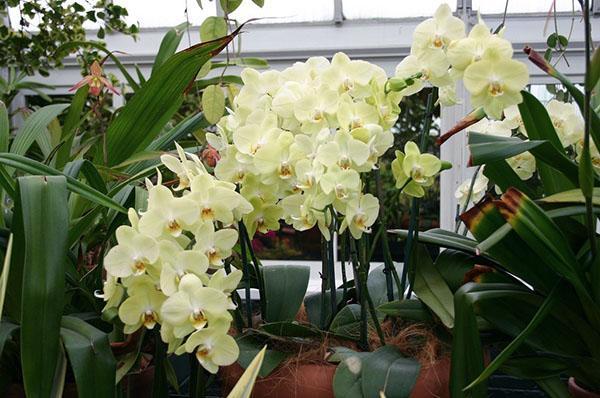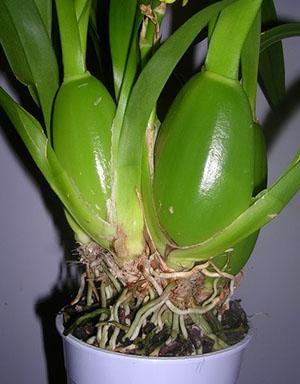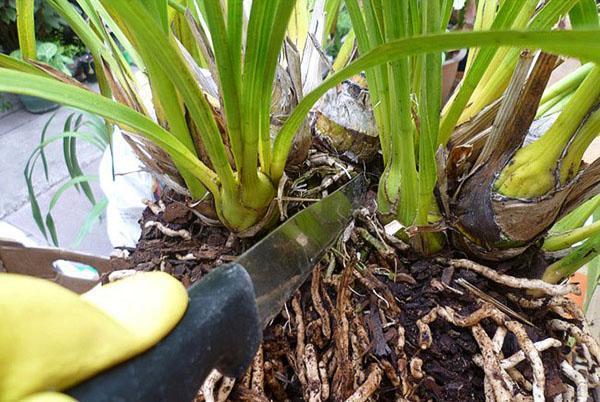How to propagate an orchid at home
 Orchids are so beautiful and amazing, having become the owner of one plant, the florist will definitely think about replenishing the collection. And after mastering the basics of care, the question arises: "How to propagate an orchid at home?"
Orchids are so beautiful and amazing, having become the owner of one plant, the florist will definitely think about replenishing the collection. And after mastering the basics of care, the question arises: "How to propagate an orchid at home?"
Read also about Phalaenopsis - the butterfly orchid!
It turns out that tropical guests are not as capricious and mysterious as it might seem to a novice florist. All indoor orchid plants can be propagated vegetatively, but it is important to know which type the green pet belongs to:
- Sympodial orchids have multiple growth points that form on horizontal shoots. As the sprout develops, it becomes a full-fledged rosette with a pseudobulb at the base.
- Monopodial plants develop from only one point, and daughter rosettes may emerge from dormant buds on the peduncle.
Due to the difference in structure, the reproduction of orchids of these two varieties has its own characteristics. But in any case, it is worth starting this work in the spring, when the green pet completes the winter dormant period, has a good rest from the previous flowering and is preparing for a new one.
How to propagate an orchid by dividing a bush?

How do orchids reproduce in this way, and what will it take to divide an adult plant? It is worth preparing in advance:
- new containers for young orchids;
- some amount of fresh substrate;
- crushed charcoal or activated carbon;
- a sharp, sterilized knife.
The flower extracted from the pot is divided into parts so that each new plant has its own root system and at least 2-3 full-fledged pseudobulbs with a supply of nutrients.
 To prevent decay, cuts of rhizomes are dipped in crushed coal, orchids are slightly dried and transferred to their own pots of a suitable diameter.
To prevent decay, cuts of rhizomes are dipped in crushed coal, orchids are slightly dried and transferred to their own pots of a suitable diameter.
If some of the plots received too few roots to quickly acclimatize in the substrate, it is better to place them in a bag with wet sphagnum and close tightly. At constant high humidity, roots are formed much more actively. When a root system sufficient for independent life is formed, the young orchid can be transplanted into a substrate for adult specimens.
When starting to reproduce an orchid at home, some growers make a serious mistake when they do not leave young pseudobulbs on the mother plant. This leads to slower growth and less frequent flowering of a previously strong flower.
 To simplify the process of reproduction of the orchid, a year before, small cuts are made on the rhizomes of the plant in the places where the bush is supposed to divide. This technique activates root formation on daughter pseudobulbs and will push the buds to grow. By next spring, the mother orchid will be strong enough not to lose growth after transplantation, and the resulting delenki will be able to immediately settle in their own pots.
To simplify the process of reproduction of the orchid, a year before, small cuts are made on the rhizomes of the plant in the places where the bush is supposed to divide. This technique activates root formation on daughter pseudobulbs and will push the buds to grow. By next spring, the mother orchid will be strong enough not to lose growth after transplantation, and the resulting delenki will be able to immediately settle in their own pots.
How to propagate an orchid by cuttings at home?
 Cutting is suitable for monopodial type orchids and is carried out in the spring.The top is cut off from a healthy adult plant so that several living succulent aerial roots are sure to remain on it. The cut on the mother plant and the apical cuttings is sprinkled with coal powder, treated with fungicide and garden varnish.
Cutting is suitable for monopodial type orchids and is carried out in the spring.The top is cut off from a healthy adult plant so that several living succulent aerial roots are sure to remain on it. The cut on the mother plant and the apical cuttings is sprinkled with coal powder, treated with fungicide and garden varnish.
 Strong stalk does not require additional maintenance. After the orchid is propagated, it is transplanted into a separate pot according to the size of the rosette and root system and placed in a greenhouse with moist warm air. A pot with the rest of an adult flower is also transferred here. Soon, new shoots from axillary buds will appear on the "hemp".
Strong stalk does not require additional maintenance. After the orchid is propagated, it is transplanted into a separate pot according to the size of the rosette and root system and placed in a greenhouse with moist warm air. A pot with the rest of an adult flower is also transferred here. Soon, new shoots from axillary buds will appear on the "hemp".
If the formation of daughter outlets is slowed down, or dormant buds do not want to wake up in any way, you can treat them with a special hormonal paste or a solution of plant hormones for orchids.
To do this, the leaf near the bud is carefully cut off and primary processing is carried out. Hormones are re-affected in 5-10 days.
Reproduction of an orchid by a peduncle
 A young plant of a monopodial orchid can also be obtained from a peduncle that has completed its task. True, before propagating an orchid in this way at home, you will have to wait until the plant has completely bloomed:
A young plant of a monopodial orchid can also be obtained from a peduncle that has completed its task. True, before propagating an orchid in this way at home, you will have to wait until the plant has completely bloomed:
- The shoot is cut at the base and divided into cuttings, so that each has a knot with a dormant bud.
- The prepared planting material is treated with a fungicide and spread over the surface of wet moss so that the bud is not immersed in the substrate.
- The cuttings are left under the film at room temperature until an independent rosette with a root system is formed in the nodes.
- All this time, the planting is regularly sprayed, preventing rotting of the cuttings and the formation of mold.
How to propagate an orchid by cuttings if there is no moss?
You can root cuttings in plain water, but the container should also be covered with a bag to maintain a stable temperature and humidity.
If the plant is not weakened after flowering and is completely healthy, it is not necessary to cut the peduncle to obtain daughter rosettes. How to propagate an orchid at home in this way? You just need:
- choose a strong bud at the top of the shoot;
- very carefully cut and remove the surface scales;
- treat the kidney with cytokinin paste, applying a portion the size of a millet grain.
 In the summer, in warmth and with high humidity, a sprout will appear from such a bud. Over time, it will grow into a small rosette with its own roots and can be detached and transplanted into a small pot.
In the summer, in warmth and with high humidity, a sprout will appear from such a bud. Over time, it will grow into a small rosette with its own roots and can be detached and transplanted into a small pot.
Orchid propagation by daughter rosettes
 Orchids with succulent jointed shoots are easy to propagate with lateral shoots emerging from the axils. But before propagating an orchid, it needs to create favorable conditions for this, ensuring:
Orchids with succulent jointed shoots are easy to propagate with lateral shoots emerging from the axils. But before propagating an orchid, it needs to create favorable conditions for this, ensuring:
- the abundance of nitrogen in the substrate;
- increased air humidity;
- stay in a warm room.
Side shoot buds are formed at the nodes. When they have their own roots, small orchids can be cut from the mother plant. If there is no way to wait for the full development of the rosettes, the entire stem is cut off and divided into parts so that there is one sprout on each segment.
 An adult plant with this method of orchid propagation develops in 2-3 years. A video on the reproduction of orchids at home will help in theory prepare for this interesting, but difficult process and will not allow you to make annoying mistakes in practice.
An adult plant with this method of orchid propagation develops in 2-3 years. A video on the reproduction of orchids at home will help in theory prepare for this interesting, but difficult process and will not allow you to make annoying mistakes in practice.
Orchid propagation by seeds
This method of obtaining young plants is considered the most laborious and is practically not used anywhere, except in specialized laboratories. The reason is in the special structure and type of seeds of this culture.
 The plant rudiments in seeds have no supply of nutrients and no protection from external hazards such as infections, pests or changes in weather conditions.
The plant rudiments in seeds have no supply of nutrients and no protection from external hazards such as infections, pests or changes in weather conditions.
Therefore, before propagating an orchid at home using this method, a florist needs to repeatedly weigh his strengths and capabilities.
Read also the article: how to transplant an orchid at home!
Good afternoon, please tell me what to do, I divided the peduncles into cuttings, everything is as written, processed, put in paonix, sprayed, and after a few days there was a smell of mold, what did I do wrong, should I open the film or not?
It is imperative to ventilate so that condensation does not form on the film.
Thank you so much
Hello! but what to do with the roots that grow out?